Industrial Temperature Control Equipment
Kontaktieren Sie uns noch heute für die perfekte Lösung zur Temperaturkontrolle
Definition of industrial temperature control equipment
Industrial temperature control equipment is a temperature control system that can automatically regulate the industrial production process. It monitors the temperature in real time through the sensor and transmits the temperature signal to the controller. The controller compares and calculates according to the preset temperature range, and then controls the heating or cooling equipment through the actuator to keep the temperature within the preset range.
The principle of industrial temperature control equipment
industrial temperature control equipment is used to measure, monitor and control temperature. It consists of several components including sensors, controllers, actuators and displays. The sensor is used to measure the ambient temperature and transmit the data to the controller. The controller is a central processor responsible for receiving and processing the data provided by the sensor, and making judgments and processing according to the preset temperature range. The actuator adjusts the temperature according to the controller’s instructions to keep it within the preset range. Finally, the display is used to show real-time conditions of the ambient temperature and parameters set by the controller.
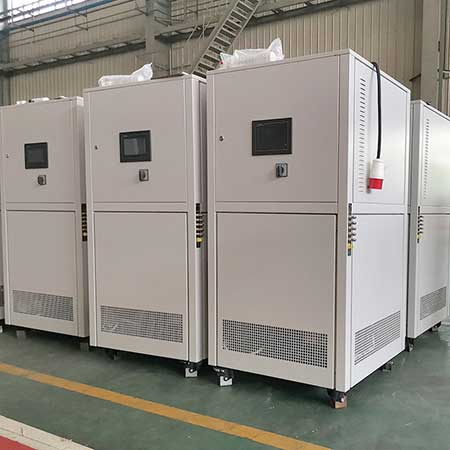
Features and advantages of industrial temperature control equipment
1. Intelligentization: With the development of artificial intelligence technology, industrial temperature control systems will become more intelligent. It can automatically adjust temperature control parameters and improve control accuracy and stability by learning and analyzing a large amount of data.
2. Energy saving and environmental protection: Industrial temperature control systems will pay more attention to energy saving and environmental protection. It can reduce energy consumption and environmental pollution by optimizing control strategies and using efficient heating or cooling equipment.
3. Multi-parameter control: Industrial temperature control systems will not only be limited to single temperature control, but will also consider the control of other parameters, such as humidity, pressure, etc. This will better meet the needs of different industries.
4. Remote monitoring: With the development of Internet technology, industrial temperature control systems will realize remote monitoring. Production personnel can remotely monitor and adjust the temperature through mobile phones or computers, improving production efficiency and convenience.
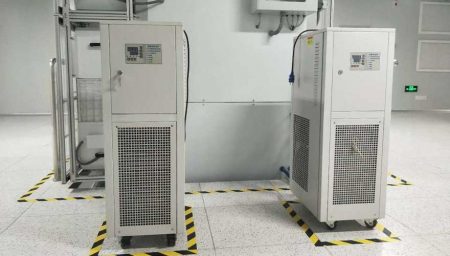
Application fields of industrial temperature control equipment
1. Petrochemical industry: In oil refining and chemical production, industrial temperature control systems can stabilize the temperature of reactors, distillation towers and other equipment to ensure the smooth progress of the production process.
2. Electronic manufacturing industry: In the manufacturing process of semiconductors and electronic components, industrial temperature control systems can control the temperature of equipment to ensure product quality and performance.
3. Food processing industry: During food heating, baking, freezing and other processes, industrial temperature control systems can control the temperature of food to ensure the taste and quality of food.
4. Pharmaceutical industry: During the production and storage of drugs, industrial temperature control systems can control the temperature of drugs to ensure the effectiveness and stability of the drugs.
5. Agriculture: Temperature control systems are usually used in greenhouses. For example, the temperature in the greenhouse needs to be strictly controlled in winter to ensure the growth of crops. The temperature control system can realize constant temperature or variable temperature control to adapt to the growth needs of different types of crops.
6. Automobile manufacturing industry: Temperature control systems are often used in manufacturing industries, especially in high-precision manufacturing. For example, in automotive engine manufacturing, engine parts require precise temperature control to ensure part quality and reduce work time. The temperature control system can monitor and control the temperature of machine parts to ensure the stability of the production environment and improve production efficiency.

The future development trend of industrial temperature control equipment
With the continuous development of technology, there will be more innovations and improvements in temperature control systems in the future. The following are several future development trends:
1. Application of cloud technology and Internet of Things
By using cloud technology and the Internet of Things, temperature control systems can be better remotely monitored and controlled. Technological developments will increase the scalability and customizability of temperature control systems.
2. Application of AI technology
AI technology has become a hot topic in many industries. Applying AI technology to temperature control systems can help improve control accuracy and enable intelligent monitoring and control.
3. Application of new materials
The development of new materials will make controllers lighter and more powerful. New materials can also make sensors more sensitive and have higher control accuracy.
Wir bieten die Entwicklung und Herstellung kompletter Temperaturkontrollsysteme an. Von Standardmodellen bis zu kompletten kundenspezifischen Produkten bis hin zu 900 Tonnen. Wir haben uns auf den Kundenservice spezialisiert und sind bestrebt, jedem Kunden zu helfen, das optimale Temperaturkontrollsystem für seinen spezifischen Bedarf zu finden.
Wir bieten maßgeschneiderte Lösungen, die nicht dem Standard entsprechen. Es sind sowohl einzelne Kühlaggregate als auch kombinierte Kühl- und Heizaggregate erhältlich.
E-Mail: info@lneya.com WeChat ID: +8615251628237 WhatsApp: +86 17851209193

Kühl- und Heizsysteme (Serie SUNDI)
Temperaturregelbereich: -120°C bis +350°C
Kühl- und Heizungsthermostate, die in verschiedenen Industriezweigen weit verbreitet sind.
| Temperaturbereich | Serie -10 ~ +150°C | Serie -25 ~ +200°C | Serie -25 ~ +300°C | Serie -45 ~ +250°C | Serie -45 ~ +300°C | Serie -60 ~ +250°C | Serie -60 ~ +300°C | Serie -70 ~ +250°C | Serie -80 ~ +250°C | Serie -90 ~ +250°C | Serie -100 ~ +100°C | ||
| Kühlleistung | 1,5 ~ 15kW | 1 ~ 200kW | 1 ~ 200kW | 0,45 ~ 200kW | 0,9 ~ 25kW | 0,25 ~ 60kW | 0,75 ~ 25kW | 0,4 ~ 15kW | 0,3 ~ 80kW | 0,2 ~ 80kW | 0,45 ~ 80kW | ||
| Hinweis: Jeder Temperaturbereich von -150℃ ~ +350℃ und jede Kühlleistung kann angepasst werden | |||||||||||||
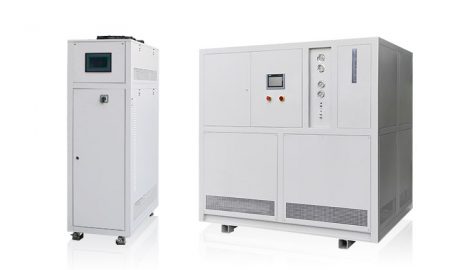
Kühl- und Heizsysteme (WTD-Serie)
(Mikrokanal / Röhrenreaktoren spezialisiert)
Temperaturregelbereich: -70°C bis +300°C
Spezielles Design für Mikrokanäle (geringe Flüssigkeitsspeicherkapazität, starke Wärmeaustauschkapazität, Zirkulationssystem mit hohem Druckabfall)
| Temperaturbereich | -70°C ~ +300°C | -45°C ~ +250°C | -70°C ~ +200°C | ||||||
| Kühlleistung | 1.1 ~ 7.5kW | 1.5 ~ 5.5kW | 11 ~ 50kW | ||||||
| Hinweis: Jeder Temperaturbereich von -150℃ ~ +350℃ und jede Kühlleistung kann angepasst werden | |||||||||

Umwälzpumpen für Kühlung und Heizung
Temperaturregelbereich: -45°C bis +250°C
| Temperaturbereich | Serie -25°C ~ +200°C | Serie -45°C ~ +250°C | |||||||
| Kühlleistung | 1 ~ 15kW | 0,25 ~ 15kW | |||||||
| Hinweis: Jeder Temperaturbereich von -150℃ ~ +350℃ und jede Kühlleistung kann angepasst werden | |||||||||
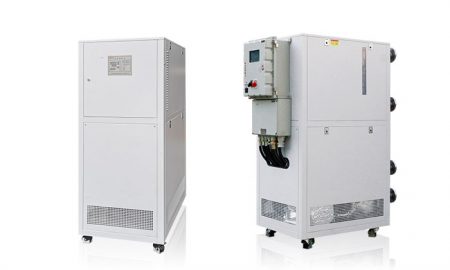
Heizungsumwälzpumpen
Temperaturregelbereich: +50°C bis +300°C
Hinweis: Die UC-Serie kann die Temperatur des Wärmeträgermediums regeln. Die UST-Serie kann nicht nur die Temperatur des Wärmeträgermediums, sondern auch die Temperatur des Reaktionsmaterials regeln.
| Temperaturbereich | +50°C ~ +170°C (UC-Serie) | +50°C ~ +300°C (UC-Serie) | +50°C ~ +300°C (UST-Serie) | ||||||
| Heizleistung | 5,5 ~ 15kW | 3,5 ~ 130kW | 3,5 ~ 95kW | ||||||
| Hinweis: Jeder Temperaturbereich von -150℃ ~ +350℃ und jede Kühlleistung kann angepasst werden | |||||||||
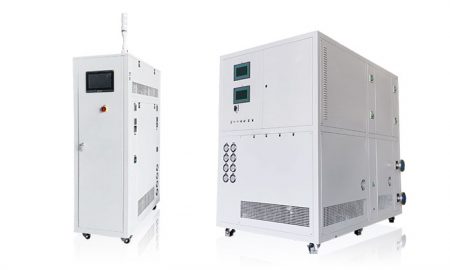
TES-Reihe
Temperaturregelbereich: -85°C bis +250°C
| Temperaturbereich | Serie -45°C ~ +250°C | Serie -85°C ~ +200°C | Serie -60°C ~ +200°C | ||||||
| Kühlleistung | 0,3 ~ 25kW | 0,25 ~ 25kW | 3 ~ 60kW | ||||||
| Hinweis: Jeder Temperaturbereich von -150℃ ~ +350℃ und jede Kühlleistung kann angepasst werden | |||||||||

LTS-Serie (fluorierte Flüssigkeit)
Temperaturregelbereich: -80°C bis +80°C
| Temperaturbereich | -20°C ~ +80°C Reihe | Serie -45°C ~ +80°C | Serie -60°C ~ +80°C | Serie -80°C ~ +80°C | |||||
| Durchflusskontrolle | 7 ~ 45 L/min | 7 ~ 45 L/min | 7 ~ 45 L/min | 7 ~ 45 L/min | |||||
| Hinweis: Jeder Temperaturbereich von -150℃ ~ +350℃ und jede Kühlleistung kann angepasst werden | |||||||||
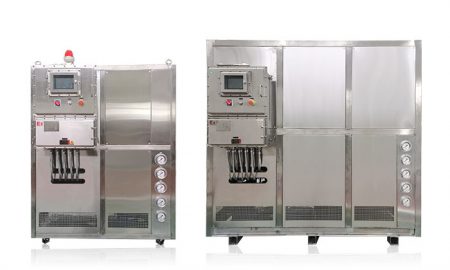
TCU Multireaktoren Temperaturkontrollsystem
Temperaturregelbereich: -120°C bis +250°C
| Temperaturbereich | Serie -45°C ~ +250°C | -120°C ~ +250°C Reihe | Kundenspezifisches Temperaturkontrollsystem | RT+10°C ~ +135°C | |||||
| Heizleistung | 25 ~ 80kW | 25 ~ 80kW | Benutzerdefiniert | 25 ~ 300kW | |||||
| Hinweis: Jeder Temperaturbereich von -150℃ ~ +350℃ und jede Kühlleistung kann angepasst werden | |||||||||

Rückkühler / Umwälzkühler
Die Kältemaschine kann in verschiedenen Industrien und Labors eingesetzt werden und unterstützt kundenspezifische Designs.
| Temperaturbereich | Serie -25°C ~ +30°C | -45°C ~ +30°C Reihe | Serie -60°C ~ -20°C | Serie -80°C ~ -20°C | Serie -120°C ~ -70°C | ||||
| Kühlleistung | 0,8 ~ 30kW | 0,75 ~ 12kW | 0,4 ~ 6kW | 0,2 ~ 6kW | 0,3 ~ 5kW | ||||
| Hinweis: Jeder Temperaturbereich von -150℃ ~ +350℃ und jede Kühlleistung kann angepasst werden | |||||||||
 Kaltwassersätze / Kleinkaltwassersätze
Kaltwassersätze / Kleinkaltwassersätze
Die Kältemaschine kann in verschiedenen Industrien und Labors eingesetzt werden und unterstützt kundenspezifische Designs.
| Temperaturbereich | -18°C ~ +30°C | +5°C ~ +35°C Reihe | |||||||
| Kühlleistung | 0,35 ~ 0,9kW | 1,8 ~ 50kW | |||||||
| Hinweis: Jeder Temperaturbereich von -150℃ ~ +350℃ und jede Kühlleistung kann angepasst werden | |||||||||

Niedertemperatur-Kühlgeräte
Wir haben uns auf die Herstellung von Niedertemperaturkältemaschinen mit einem Temperaturregelbereich von bis zu -150°C spezialisiert, die den Kühlbedarf verschiedener Branchen decken.
| Temperaturbereich | Serie -25°C ~ -5°C | Serie -45°C ~ -10°C | Serie -60°C ~ -10°C | Serie -80°C ~ -30°C | Serie -110°C ~ -50°C | Serie -150°C ~ -110°C | |||
| Kühlleistung | 12 ~ 360kW | 6 ~ 180kW | 6 ~ 180kW | 4 ~ 180kW | 2 ~ 120kW | 2,5 ~ 11kW | |||
| Hinweis: Jeder Temperaturbereich von -150℃ ~ +350℃ und jede Kühlleistung kann angepasst werden | |||||||||
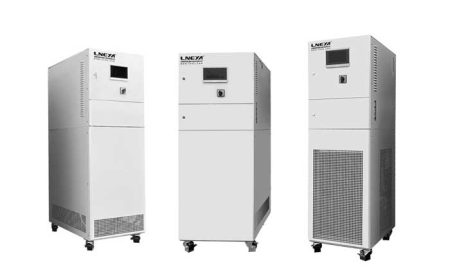
Hochtemperatur-Kühlgeräte
Die Kältemaschine kann in verschiedenen Industrien und Labors eingesetzt werden und unterstützt kundenspezifische Designs.
| Temperaturbereich | +5°C ~ +40°C | -25°C ~ +40°C | -45°C ~ +40°C | -80°C ~ +80°C | -100°C ~ +80°C | ||||
| Kühlleistung | 6 ~ 40kW | 2 ~ 15kW | 1 ~ 8kW | 0,6 ~ 3kW | 1,5 ~ 3kW | ||||
| Hinweis: Jeder Temperaturbereich von -150℃ ~ +350℃ und jede Kühlleistung kann angepasst werden | |||||||||
 LNEYA
LNEYA
 简体中文
简体中文


















































































